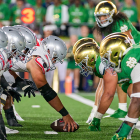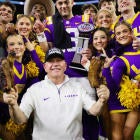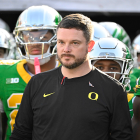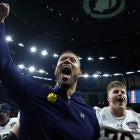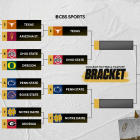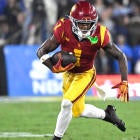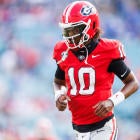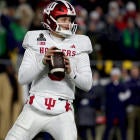TUSCALOOSA, Ala. -- Damien Harris knows he is being preserved as much -- or as little -- as he is being played by Nick Saban.
Through eight games, the junior from Richmond, Kentucky, leads No. 2 Alabama in rushing yards (697) and yards per carry (8.6). Yet, he is only averaging slightly more than 10 carries per game.
That figure is tied for 19th in the SEC and not even among the top 100 nationally. He's also on track for a career year as Bama prepares for No. 19 LSU on Saturday.
"There were games Derrick Henry would have 40 carries, 50 carries," Harris said of Alabama's 2015 Heisman winner. "Nobody had ever heard of it."
Henry was an extreme workhorse not only that year but almost any year. With backup Kenyan Drake injured, Henry became perhaps the most-used tailback in recent years. His 395 carries -- 90 of those in a two-game stretch -- remain the most for any player since 2007.
Henry was a Heisman Trophy-winning one off. The nation's best running backs continue to come to Alabama armed with the knowledge of what they will not become.
Overused.
"At your position," Saban tells his prospects, "which has the shortest shelf life of any position at the next level, the fact that we're not wearing your tread out on your tires … is probably a benefit to you."
Because of -- or despite -- that philosophy, Saban has assembled one of the deepest backfields in recent years. The philosophy also goes against the natural teenage high school star's quest for fame.
"It's weird because we've got five-guys here that I think could go anywhere else and be that guy," Harris said.
They all buy into a mantra that has been cooked into the recruiting philosophy not only here but increasingly across the nation.
"It's pretty simple," Georgia coach Kirby Smart began, "you have a three-year window [before getting to the NFL]. A lot of the greatest backs don't want a ton of physicality on the body. You want to share the load. They're going to judge you based on the carries you get, not the ones you don't get."
Smart is not only a former Saban assistant but a disciple. He has landed his own set of superstar backfield talent. Helping replace Sony Michel and Nick Chubb will be top-10 talent Zamir White and Dalvin Cook's brother, James Cook.
"They'll draft a guy on 10 carries if he carries it really good those 10 times," Smart said. "We sell kids on that. You're going to be fresh. The pros are going to see you as a valuable asset. You're going to share the load."
At most places, having three that can play is amazing. Five is stocking the cupboard with enough food for doomsday. The amazing thing is they've all chosen to come here knowing it's pretty much running back socialism.
That is, by committee.
The NFL has long rotated its backs, as much strategy as protecting an investment. Since 2010, only three Alabama tailbacks have averaged more than 15 carries per game. The only two Heisman winners in school history have played since 2009. Both were tailbacks.
"You kind of only have limited attempts to showcase your ability," said Harris, Alabama's leading rusher in 2016. "I don't think that's a negative thing. We're all appreciative of it. It keeps us from getting tired. It keeps us from getting banged up. It keeps us from getting worn down."
It keeps Alabama on top. Recruiting experts say any of Alabama's top five running backs could start at most places -- never mind that all five are constantly clawing and scratching for playing time in Tuscaloosa.
The strategy works. Alabama is having its best rushing season by far under Saban, almost 300 yards per game.
"All we have is us," Harris said.
Yes, but there sure are a lot of y'all.
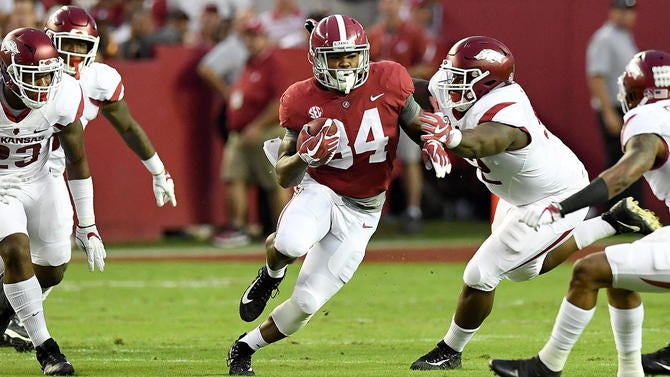
Here is a snapshot of a stacked depth chart …
The Starter: Damien Harris was a five-star prospect, No. 1 at his position, per 247Sports, and 32nd nationally in 2015. Currently, he's third nationally in yards per carry.
The Pounder: Bo Scarbrough, another junior five-star prospect, was No. 2 at his position and 16th nationally in 2015 from Tuscaloosa. He has the same amount of carries as Harris (81) and is the closest thing to Derrick Henry, physically.
The Next One: Sophomore Josh Jacobs was a three-star prospect, the No. 11 all-purpose back and 471st nationally in 2016 from Tulsa, Oklahoma. Running backs coach Burton Burns saw him play basketball in high school and knew he was a talent. He's the best combination of speed and shiftiness among the five.
The Phenom: Freshman Najee Harris was a five-star prospect, the No. 1 running back and No. 2 overall in 2017 from Antioch, California. A lot of services considered him the best player in the country.
The Local: Freshman Brian Robinson was a four-star prospect, the No. 8 running back and No. 145 overall in 2017 from Tuscaloosa. He has only 17 carries as a rookie, averaging almost 7 yards per attempt. How many fifth-string freshmen could start for other schools? This one could.
"Get in front of him, nine times out of 10 he wants to run you over," Scarbrough said. "Brian Robinson is going to be very good. When he came in he was a step ahead of where Damien and I were."
None of the above includes the scrambling ability of sophomore quarterback Jalen Hurts, the leading ball-carrier (84 attempts) and second-leading rusher (572 yards).
"I tell the players when I was a pro coach I never looked at a whole game [on tape]," Saban said. "They always made a cut-up of the [running back] that was playing. So if he played 16 plays in this game and 12 plays in the next game or 25 plays in the next game, I didn't really know about that.
"All I watched is how he played when he got in."
The easy answer on why they continue coming here is … it's Alabama. You're going to win. You're going to be seen by scores of NFL scouts. If the average NFL running back lasts 3 ½ years, this is the perfect prep academy. The line of succession under Saban has gone from Glen Coffee to Mark Ingram to Trent Richardson to Eddie Lacy to T.J. Yeldon to Derrick Henry to Damien Harris. Those are his leading rushers at Alabama.
Among those who are gone, none were drafted lower than the third round. Two were taken in the first. They've lasted a combined 21 NFL seasons running for a combined 12,651 yards.
Saban is so intent on preserving bodies that he doesn't conduct full-tackle practices anymore. Instead, even on the most intense practice days of the week -- usually Tuesday and Wednesday -- Crimson Tide players aren't allowed to take each other to the ground.
"We never do it," Saban told me. "We never tackle anybody to the ground. My goal is to never have anybody on the ground in practice. … Almost every player I can remember got injured in practice is somebody being on the ground."
The so-called "thud" practice technique has been around for a while. Players go full speed to a ballcarrier until contact, then throttle down, not taking him to the ground. The technique was developed as concerns grew over head trauma.
The No. 1 team in the land takes it … easy? Hardly. The game has evolved to protect its most valuable resources – the players. Save the violence for the game. Ivy League teams are in the second year of eliminating full-contact hitting from their practices. The Canadian Football League eliminated full-contact padded practices in September.
NCAA guidelines -- though they're not rules -- state that live tackling in practice should be limited to two days a week during the season. The Pac-12 limits full-contact practices to two per week.
"You think you're protecting players but when they actually do start hitting people do they get injured more?" Saban asked. "I don't the answers to those questions, but I think they're good questions."
Has that practice led to more healthy Alabama running backs and Crimson Tide players overall? It can't hurt if you consider the Ivy League discovered a "significant drop" in injuries by merely moving kickoffs up five yards. All of it has been done in the name of player safety. Do the simple math. The less you hit, the fewer injuries there are. Of course, purists will argue a lack of hitting does more harm than good for the aesthetics of the game.
"A lot of [NFL] teams, when they have a bye week, don't practice at all," Saban added. "If we did that, we would get beat by 40 points in the next game."
The bottleneck at running back -- if that's what it is -- may resolve itself if Scarbrough and Harris declare for the draft.
"A lot of these guys coming out of high school are so focused on, 'Where can I play as a freshman?' Saban said. "Yet, when I ask them what their ultimate goal is, they say they want to play in the NFL. Where are you going to be three years from now when the NFL starts to look at you? You want to go some place where you can develop. We have a pretty good track record."
That Saban record would include 25 underclassmen going out early for the draft while at Alabama.
"That's 25 times 32 conversations with NFL GMs about juniors," Saban said. "Not one of them asked me how much they played as freshmen."
That's a subtle way of saying something that doesn't have to be said within with the walls of the football facility: Wait your turn.
It's understood here.
"You can't be that selfish player, but you've got to be selfish, if that makes sense," Scarbrough said. "You've got to make the most of the chance you get."









